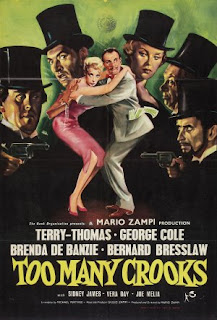I was afraid I was going to see Anthony Perkins do just another version of Norman Bates in this, but due to one of the interesting changes to the movie script Dennis Pitt is not only fully aware of his fantasy life of being a CIA agent he shares those weird stories and fantasies with everyone. So in the opening scene where we see him meeting with his parole officer for the first time (a scene not in the book) he is playing with Azenauer and teasing him. Dennis makes fun of his apparent diagnosis of mental illness with a story of aliens being responsible for polluting the town's water supply. Azenauer then cautions him about indulging in those wild stories. He's supposed to be rehabilitated and ready for the real world now. Dennis smirks, tosses off the advice, and heads out to start his new life.
Immediately afterward he sees Sue Anne for the first time and is entranced. She happens to be dressed as a drum majorette and is inexplicably marching down the street with her high school marching band. This image allows for a recurring musical motif throughout the movie that signals Dennis is daydreaming and drifting off into his private world. The marching band also adds a surreal element that will pervade the movie tying into Dennis' refusal to commit to entering the real world despite all the advice given to him by his landlady, parole officer and other adults.
The strength of the movie is in the scenes between Tuesday Weld and Anthony Perkins. They have an fascinating chemistry together. Weld seems like an easily impressed, easily manipulated teenage girl sick of adults and her homelife and craving adventure. She oozes enthusiasm and cheerfulness but is never cloying or stupid. There are sly hints about what she's really up to if you already know the ending. It was fascinating to see her play the subtext in the early part of the movie. What I didn't think was a wise choice was to turn her into another two-timing noir temptress.
The film devolves into a series of histrionic scenes beginning with arrest of Dennis at the hands of some hysterical policemen and ending with Sue Anne in the police station revealing that she turned him in. In the book Dennis makes this decision to call the police and confess to the crime himself because he finally realizes that he will never fit into the real world and wants to do the right thing by sparing the girl he has fallen in love with. Yet no matter how hard he tries to be believable he's still treated as if he's a lunatic. It's more effective and tragic than having him become a victim of Sue Anne's devilish betrayal.
In fact Dennis is made to out to be a cowering baby when it comes to actually doing something deadly. Perkins quivers and gives us his wide-eyed innocent looks while Weld laughs and giggles and is turned on by all the violence done mostly at her hands. Too many scenes in the original story where Dennis is complicit in the violence are removed. Weld's Sue Anne is turned into a cackling psycho in the climactic murder scene collapsing into laughter on her bed surrounded by the framed ballet dancers and flowery wallpaper of her girly bedroom. An unsettling scene for sure, but to my mind not really right for Geller's intended themes.
 |
| John Randolph (right) as Azenauer, more of a father figure than a parole officer |
The only adult character who remains true to the original story is Sue Anne's mother even more of a harpy than she was in the book. As played by Beverly Garland Mrs. Stepanek is the best supporting part in the movie. She is epitome of the bitch mother. Philandering with wannabe hunks and yet keeping a tight control on her "slut" daughter who is only following in her mother's footsteps. Garland appears in three scenes but she makes the most of them delivering her lines with vehement gusto, puffing away on a cigarette, slapping her daughter like Ida Lupino in Women's Prison. It's no wonder Dennis retreats to the kitchen or inches his way to the front door when in her presence. No one would want to be in the same room with such a Fury.
The movie works largely thanks to the presence of Perkins and Weld and their very magnetic chemistry. Their scenes are the strongest, most powerful and most imaginatively composed and lit. If there are a few unintentionally campy moments like the shot of Sue Anne straddling her first murder victim like she's won a wrestling contest or some dreadful dialogue like Perkins oft quoted "What a week...!" speech they only enhance the weirdness of the movie. This is supposed to be a story of young people -- a 22 year old man and a 17 year old girl -- committing sabotage, murder and having drug enhanced sex in the 1960s. Watching two people much older than their parts (Perkins was 36, Weld 25) carry off their roles with 100% commitment and never once parodying themselves or their past roles is both impressive and wildly entertaining.





















































